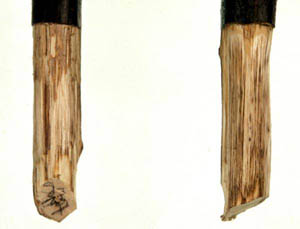Oak Wilt Testing
June 6, 2007
Oak wilt is a vascular disease caused by a fungus that plugs up the vascular system of the tree. The foliage of the infected tree may become scorched, or it may turn gray/green or tan. The effect will not go unnoticed, especially if the tree is a landscape tree; but it is important to notice symptoms as soon as possible to help surrounding oaks. The disease progresses quickly, killing mature trees in the red oak group in one season. The symptoms often start in the top of the tree, so don't neglect looking there for problems. Binoculars work well for large trees. Make it a habit to look at your plants often. That is part of enjoying your landscape. Vascular diseases such as oak wilt are more apparent now that other foliage is a deep green. If you see a problem on your oak, look at other tree species in the area. Oak wilt infects only oaks. If other trees are showing similar symptoms, then consider site or environmental stress.
Leaf symptoms vary depending on the oak species involved. Generally oaks in the red or black oak group (pointed leaf lobes) develop discolored and wilted leaves at the top of the tree or at the tips of the lateral branches in late spring and early summer. The leaves curl slightly and turn a dull pale green, bronze, or tan, starting at the margins. Usually by late summer, an infected tree has dropped all its leaves. In some years, we have seen red oaks progress from scorched foliage to total defoliation in as little as 3 weeks.
The white and bur oak group (rounded leaf lobes) generally shows symptoms on scattered branches of the crown. The disease is often confused with general dieback and decline. Leaves on infected white oaks become light brown or straw-colored from the leaf tip toward the base. The leaves curl and remain attached to the branches. This tree group may die in one season but is much more likely to survive for many years with dieback and stressed appearance.
There is no cure for an infected tree. Trees with early infection may be treated to help contain the fungus. So why is accurate diagnosis such a concern? The oak wilt fungus spreads from an infected tree to healthy oaks. The cost of preventing this spread can be high. By accurately identifying the disease problem, we can be sure that the money spent to protect healthy oaks is well spent. The cost of testing at the University of Illinois Plant Clinic is only $12.50 per sample.
If you sample a tree for oak wilt testing, do so before any chemicals are applied. Look for vascular discoloration to help diagnose the presence of oak wilt.

Samples should be 8 to 10 inches long, about thumb thickness, alive but showing symptoms, and must contain vascular discoloration. It takes 7 to 10 days for the fungus to develop in the lab to the point where a positive confirmation can be made from cultures.

The processing time cannot be shortened. Oak samples submitted for oak wilt testing should be sent on disposable ice packs to prevent killing the fungus (in mail trucks) with high temperatures before it can be isolated in the lab.
If you have oak wilt in your area, do not prune oaks now. Pruning when trees are actively growing results in sap flow, attracting the beetles that may carry the fungal pathogen to your tree. Both the beetles and the fungus are now active. If oak wilt is present in your area, try to leave pruning of oaks at least until after midsummer. The dormant season would be an even better time for this task. For more information about oak wilt, consult Report on Plant Disease, no. 618, "Oak Wilt and Its Control" (Adobe PDF).
Author: Nancy Pataky
